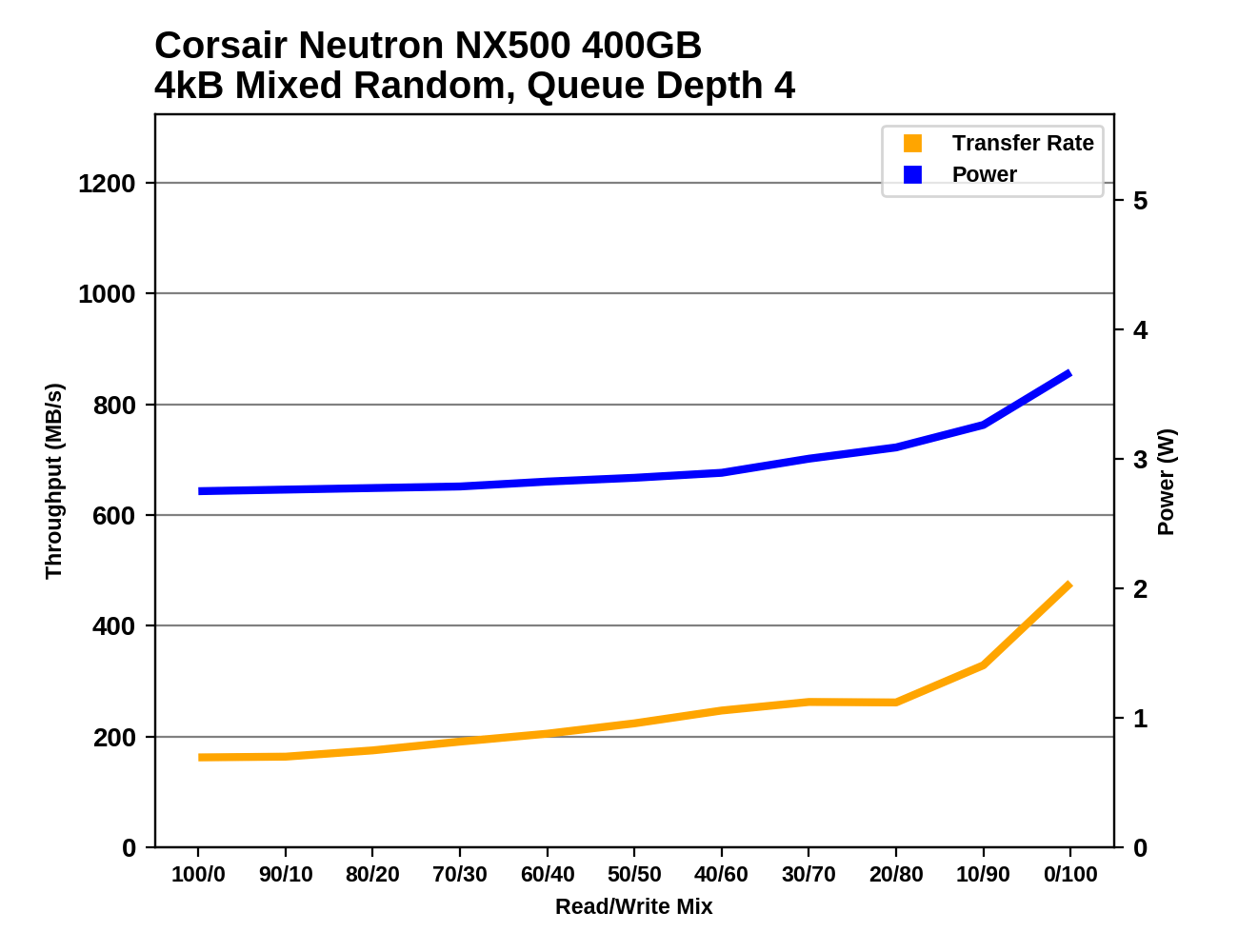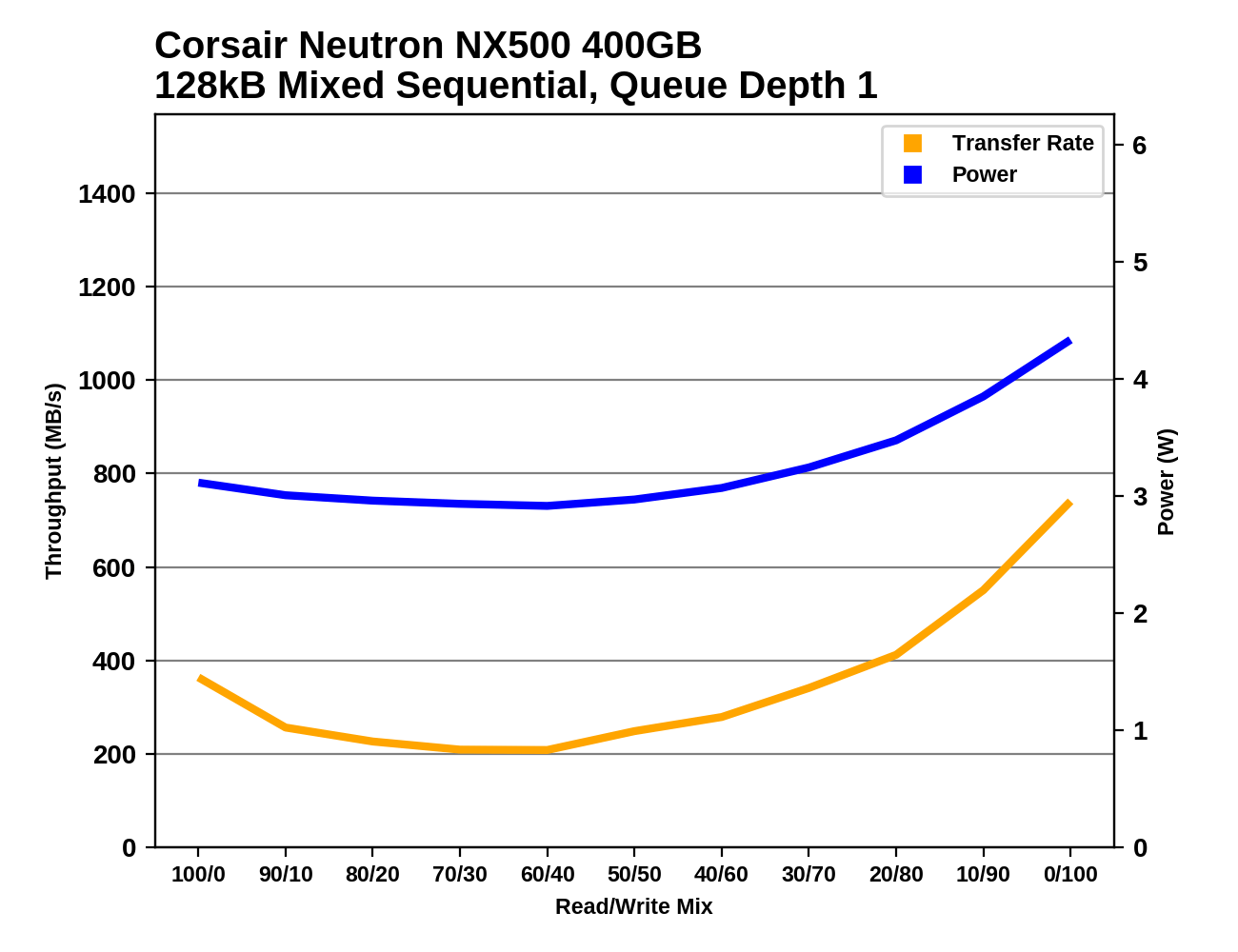The Corsair Neutron NX500 (400GB) PCIe SSD Review: Big Card, Big Pricetag
by Billy Tallis on August 16, 2017 10:00 AM ESTMixed Random Performance
Our test of mixed random reads and writes covers mixes varying from pure reads to pure writes at 10% increments. Each mix is tested for up to 1 minute or 32GB of data transferred. The test is conducted with a queue depth of 4, and is limited to a 64GB span of the drive. In between each mix, the drive is given idle time of up to one minute so that the overall duty cycle is 50%.

The QD4 mixed random I/O performance of the Corsair Neutron NX500 is pretty good overall, but the Patriot Hellfire has a clear advantage. The Zotac SONIX on the other hand can't beat the SATA-based Samsung 850 PRO and is only slightly faster than the Intel 600p.

The power efficiency of the NX500 during the mixed random I/O test is about average, while the faster Patriot Hellfire beating all the other planar NAND SSDs in this bunch.
 |
|||||||||
The performance of the Neutron NX500 increases gradually as the portion of writes increases, not dropping anywhere along the way but also not spiking very high in the final phase of the test where many drives improve greatly.
Mixed Sequential Performance
Our test of mixed sequential reads and writes differs from the mixed random I/O test by performing 128kB sequential accesses rather than 4kB accesses at random locations, and the sequential test is conducted at queue depth 1. The range of mixes tested is the same, and the timing and limits on data transfers are also the same as above.

The mixed sequential performance of the Corsair Neutron NX500 is poor, with it and the Patriot Hellfire performing slightly worse than the SATA-based Samsung 850 PRO and only beating the entry-level TLC NVMe drives. The Zotac SONIX on the other hand performed quite well, though still a bit slower than what the OCZ RD400A manages using the same NAND.

The power efficiency of the NX500 and Patriot Hellfire rank no better than their overall performance on the mixed sequential test, and the Zotac SONIX is only modestly better off.
 |
|||||||||
The NX500's performance on the mixed sequential test bottoms out with 70/30 and 60/40 read/write mixtures, but then shows good improvement as the proportion of writes continues to increase. Most of the MLC drives are able to avoid the performance drop that the NX500 suffers in the early phases of this test, which is what leads to the Zotac SONIX scoring so much better than the NX500.










45 Comments
View All Comments
Billy Tallis - Thursday, August 17, 2017 - link
The ATSB Heavy and Light tests include data from runs on a full drive, and The Destroyer writes more than enough data to put this drive into steady-state. Synthetic benchmarks of steady-state performance would not be more representative of real-world usage. Client drives do not get hammered with constant writes. I will eventually add some steady-state tests back into the test suite, but they will not be and never have been the most important aspect of a client drive review. They're useful to study how the drive handles garbage collection under pressure, but the impact that has on real-world performance is minimal.qlum - Friday, August 18, 2017 - link
The only place I wouldn't go for samsung is when you want to use a cheap 120gb ssd. At that point the cheapest samsung drives are just too expensive.Vorl - Wednesday, August 16, 2017 - link
did I miss something big, besides the card? This while a good review, is a very uninteresting product that just wastes space compared to a 4x m.2 slot.DanNeely - Wednesday, August 16, 2017 - link
You can put a card form factor drive in an older board without m.2 slots. Unfortunately the underlying Phision controller isn't much faster than older SATA models; making it another underwhelming product.DigitalFreak - Wednesday, August 16, 2017 - link
Even then you can buy a cheap PCI-E x4 to m.2 adapter for like $15. There's no reason for this card to exist at these capacities. If it was 2 or 4TB, maybe, but not 400/800GBmapesdhs - Thursday, August 17, 2017 - link
Yup, I have a 960 Pro 512GB on an Akasa card on an X79 board, does about 3.5GB/sec in CDM.Pity the review didn't mention the cheaper SM951/SM961, and they really need to get a 960 Pro to round out the data, the one I bought wasn't that much more than the EVO and it's a far better product. I don't like the 960 EVO, it's slower than the 950 Pro most of the time.
r3loaded - Wednesday, August 16, 2017 - link
> Skip to the graphs.> Another SSD that gets pwned by a 960 Evo, nevermind the Pro.
> Write this comment, ignore the rest of the review and close the tab.
creed3020 - Tuesday, August 22, 2017 - link
+1Unfortunately so, wish it wasn't......very disappointing Corsair.
timchen - Wednesday, August 16, 2017 - link
If I am not mistaken, 960 EVO 1 TB can perform quite differently to 500GB... so using the 1TB performance per dollar does not seem very fair to the 400 GB...Billy Tallis - Wednesday, August 16, 2017 - link
I do wish I had a sample of the 500GB 960 EVO, because performance does generally scale with capacity. But it's pretty safe to assume that at low queue depths and while the SLC cache isn't full, the 500GB 960 EVO will perform similarly enough to the 1TB that it still beats the Phison E7 drives.